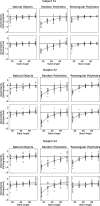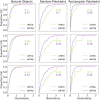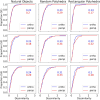Monocular reconstruction of shapes of natural objects from orthographic and perspective images
- PMID: 38686329
- PMCID: PMC11057234
- DOI: 10.3389/fnins.2024.1265966
Monocular reconstruction of shapes of natural objects from orthographic and perspective images
Abstract
Human subjects were tested in perception of shapes of 3D objects. The subjects reconstructed 3D shapes by viewing orthographic and perspective images. Perception of natural shapes was very close to veridical and was clearly better than perception of random symmetrical polyhedra. Viewing perspective images led to only slightly better performance than viewing orthographic images. In order to account for subjects' performance, we elaborated the previous computational models of 3D shape reconstruction. The previous models used as constraints mirror-symmetry and 3D compactness. The critical additional constraint was the use of a secondary mirror-symmetry that exists in most natural shapes. It is known that two planes of mirror symmetry are sufficient for a unique and veridical shape reconstruction. We also generalized the model so that it applies to both orthographic and perspective images. The results of our experiment suggest that the human visual system uses two planes of symmetry in addition to two forms of 3D compactness. Performance of the new model was highly correlated with subjects' performance with both orthographic and perspective images, which supports the claim that the most important 3D shape constraints that are used by the human visual system have been identified.
Keywords: compactness; inverse problems; monocular 3D vision; shape reconstruction; symmetry.
Copyright © 2024 Beers and Pizlo.
Conflict of interest statement
The authors declare that the research was conducted in the absence of any commercial or financial relationships that could be construed as a potential conflict of interest.
Figures












Similar articles
-
A Bayesian model of binocular perception of 3D mirror symmetrical polyhedra.J Vis. 2011 Apr 19;11(4):11. doi: 10.1167/11.4.11. J Vis. 2011. PMID: 21505106
-
Gestalt-like constraints produce veridical (Euclidean) percepts of 3D indoor scenes.Vision Res. 2016 Sep;126:264-277. doi: 10.1016/j.visres.2015.09.011. Epub 2015 Nov 3. Vision Res. 2016. PMID: 26525845 Free PMC article.
-
Visual detection of symmetry of 3D shapes.J Vis. 2010 Jun 1;10(6):4. doi: 10.1167/10.6.4. J Vis. 2010. PMID: 20884553
-
Visual shape perception as Bayesian inference of 3D object-centered shape representations.Psychol Rev. 2017 Nov;124(6):740-761. doi: 10.1037/rev0000086. Epub 2017 Sep 14. Psychol Rev. 2017. PMID: 28910127 Review.
-
Molecular Symmetry and Art: Visualizing the Near-Symmetry of Molecules in Piet Mondrian's De Stijl.Angew Chem Int Ed Engl. 2024 Jun 17;63(25):e202403754. doi: 10.1002/anie.202403754. Epub 2024 May 15. Angew Chem Int Ed Engl. 2024. PMID: 38619527 Review.
References
-
- Attneave F., Frost R. (1969). The determination of perceived tridimensional orientation by minimum criteria. Percept. Psychophys. 6, 391–396. doi: 10.3758/BF03212797 - DOI
-
- Fischler M. A., Bolles R. C. (1981). Random sample consensus: a paradigm for model fitting with applications to image analysis and automated cartography. Commun. ACM 24, 381–395. doi: 10.1145/358669.358692 - DOI
-
- Jayadevan V., Sawada T., Delp E., Pizlo Z. (2018). Perception of 3D symmetrical and nearly symmetrical shapes. Symmetry 10, 1–24. doi: 10.3390/sym10080344 - DOI
LinkOut - more resources
Full Text Sources

